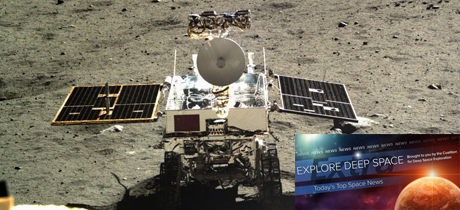In Today’s Deep Space Extra… China places a lander on the Moon’s far side, a first. NASA’s New Horizons spacecraft offers new details on Ultima Thule, the most distant celestial object every visited by a human spacecraft. Congress and the White House will attempt again to resolve a 2019 budget impasse affecting a range of civilian agencies, including NASA and NOAA.
Human Space Exploration
45th Space Wing group detachment 3 prepares for human spaceflight return
Coalition Member in the News – Boeing
Space Coast Daily (12/28): A history book, penned by NASA, spanning 30-years of manned space shuttles was now closed. Few were certain when the United States would send an astronaut into space again, if ever. Years have passed and American astronauts have been sent to the International Space Station onboard Russia’s Soyuz spacecraft, the current human spaceflight transportation vehicle, but the U.S. is gearing up to bring human spaceflight back to American soil.
As ISRO works on human spaceflight, a glimpse of its challenges from 45 years ago
The Wire (12/28): On December 28, the Government of India okayed India’s first human spaceflight programme. The programme will attempt to launch three Indian astronauts to low-Earth orbit for as many as seven days. If the mission – slated to happen in 2022 – succeeds, India will become only the fourth country in the world able to launch astronauts into space. It is not yet clear what the astronauts will do in space. The Indian Space Research Organisation (ISRO), which is leading the programme, has said they will perform some science experiments on their first flight but nothing of what comes after.
Space Science
China’s Moon landing: ‘New chapter in humanity’s exploration of the Moon’
New York Times (1/2): China became the first space power to soft land a spacecraft on the Moon’s far side during the mid-morning on Thursday in China, late on Wednesday in the U.S. An image followed. The Chang’e 4 spacecraft includes a lander and a rover. Their mission is to explore the van Karman Crater, which is part of the vast South Pole Aitkin Basin, an ancient impact site. NASA’s Lunar Reconnaissance Orbiter (LRO) and other missions have detected evidence of frozen water in the shadowed crater recesses of the region, a potential resource for future human explorers. The lander will also evaluate the south pole environment as the site for a future radar observatory. The mission, launched on December 7, represents a significant space milestone for China, which is preparing to assemble an Earth orbiting space station.
Snowman or BB8? Ultima Thule full of surprises
Spacepolicyonline.com (1/2): With ever more imagery reaching the Earth from NASA’s New Horizons spacecraft on its journey beyond its New Year’s Eve close flyby target Ultima Thule, scientists are seeing a dark reddish object that looks more like a two lobed snowman than a slowly rotating bowling pin. Ultima appears to offer a first ever look at how similar planetesimals, the building blocks of the solar system’s planets, came together during the earliest epoch of a 4.6 billion year old solar system.
Quadrantid meteors kickoff a busy January 2019
Universe Today (1/2): The annual Quadrantid meteor shower, which peaks on Thursday night, is among celestial events that can be observed this week. Add a partial solar eclipse over the weekend and visible from the Pacific region.
Other News
Houston, we have a problem — it’s Washington (Op-Ed)
Space.com (1/2): In an op-ed, Paul Shearon, president of the International Federation of Professional and Technical Engineers, many of them employed by NASA, explains why the 2019 budget impasse that forced many of the civilian federal agencies, including NASA and NOAA, into a prolonged shutdown on December 22 represents a misguided policy. NASA’s success into the future depends on a committed professional workforce with the technical and scientific skills to shoulder the agency’s difficult challenges.
Trump and congressional leaders dig in over government shutdown
Los Angeles Times (1/2): Despite a White House meeting on Wednesday, congressional leaders said they and President Trump are no closer to reaching an agreement on border security and immigration that would end a government shutdown in place since December 22 for a number of federal agencies, including NASA and NOAA. All but essential workers in those agencies, nearly 800,000 men and women, have been furloughed as a result. Members of Congress that were elected in the November midterms are to be sworn in Thursday, a milestone that could reverse the situation.
House Democrats plan to pass Senate version of FY2019 appropriations for NASA, NOAA
Spacepolicyonline.com (1/2): The function of U.S. civilian federal agencies covered by seven of 12 appropriations measures have been shut down since December 22 for lack of a comprehensive 2019 budget. A new Congress elected during the November mid-terms will be sworn in Thursday. The House, sporting a new Democratic majority, plans to combine with a Senate version of a budget measure and pass legislation covering six of the seven, including a 2019 Commerce, Justice and Science appropriations measure that includes NASA and NOAA. All but the most essential employees at NASA have been furloughed since the shutdown. Homeland Security and the fate of a controversial border wall, will be left as a separate measure. President Trump is to meet with congressional leaders later in the day to explore the possibility of resolving the budget impasse.
Deep Space Industries acquired by Bradford Space
SpaceNews.com (1/2): U.S. owned but European based Bradford Space has acquired Deep Space Industries, of San Jose, California, founded in 2012 as an asteroid mining venture. More recently Deep Space has turned its focus to the small satellite market and the development of a water based satellite propulsion system.

